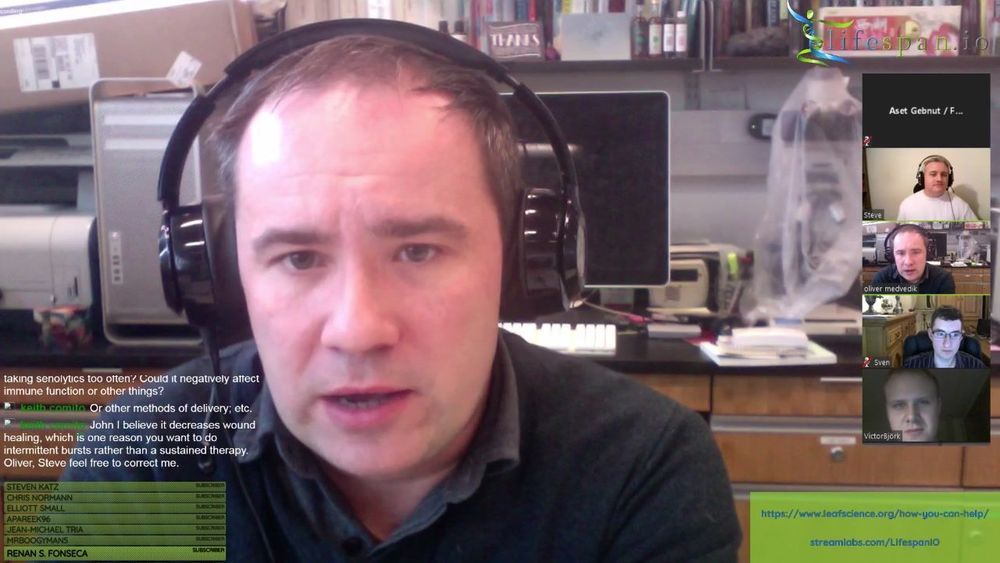Page 9146
Jan 30, 2019
Link between aging and microbiome diversity in exceptional mammalian longevity
Posted by Paul Battista in category: life extension
Pharmaceutical microbiology, quality assurance, healthcare, cleanroom, contamination control, microbiology, tim sandle, sterility, disinfection.
Jan 30, 2019
Happy birthday, periodic table
Posted by Genevieve Klien in categories: chemistry, education
Jan 30, 2019
Siberian cave findings shed light on enigmatic extinct human species
Posted by Genevieve Klien in category: futurism
WASHINGTON (Reuters) — Scientists using sophisticated techniques to determine the age of bone fragments, teeth and artifacts unearthed in a Siberian cave have provided new insight into a mysterious extinct human species that may have been more advanced than previously known.
Jan 30, 2019
Robot that thinks for itself from scratch brings forward rise the self-aware machines
Posted by Genevieve Klien in categories: innovation, robotics/AI
The rise of “self-aware” robots has come a major step closer following the invention of a machine capable of thinking for itself from scratch, scientists have said.
Engineers at Columbia University claim to have smashed one of the biggest barriers in the field of robotics after a mechanical arm, which had not been programmed with any instructions, began performing practical tasks after just a few hours.
The team said this is the first time a robot has shown the ability to “imagine itself”, thereby working out what its purpose is and how to perform it.
Jan 30, 2019
A New, Reversible Male Birth Control Lasts Months and Looks Like a Cocktail
Posted by Genevieve Klien in category: biotech/medical
Jan 30, 2019
A Robot Teaches Itself to Play Jenga. But This Is No Game
Posted by Genevieve Klien in categories: physics, robotics/AI, space
Global thermonuclear war. The slight possibility that a massive asteroid could boop Earth. Jenga. These are a few of the things that give humans debilitating anxiety.
Robots can’t solve any of these problems for us, but one machine can now brave the angst that is the crumbling tower of wooden blocks: Researchers at MIT report today in Science Robotics that they’ve engineered a robot to teach itself the complex physics of Jenga. This, though, is no game—it’s a big step in the daunting quest to get robots to manipulate objects in the real world.
You’ve read your last complimentary article this month. To read the full article, SUBSCRIBE NOW. If you’re already a subscriber, please sign in and and verify your subscription.
Jan 30, 2019
How Long Will We Live in 2069?
Posted by Lilia Lens-Pechakova in categories: biotech/medical, genetics, life extension, neuroscience
A new, very good article on aging, modern aging research and its history, RAAD feest and other initiatives, on model organisms, genetics and future lifespans. “… In early December 2018, just a few months after RAADfest, I visited the Buck Institute for a daylong symposium titled “Live Better Longer: A Celebration of 30 Years of Research on Aging.” That wasn’t an arbitrary demarcation: Aging is one of the rare areas of modern science with a specific launch date. In this case, it was January 1988, when Tom Johnson, a behavioral geneticist at the University of California, Irvine, published a paper that linked a genetic mutation he named “age-1” to longer lifespans in a transparent, microscopic, mostly hermaphroditic roundworm known in scientific circles as C. elegans. Prior to Johnson’s discovery, aging had not received a lot of attention from researchers. In the 1820s, Benjamin Gompertz, a self-trained mathematician, concluded that humans don’t start to break down at some magic age but are constantly declining and losing the ability to repair themselves, a concept now referred to as the Gompertz law of mortality. The first hint that there might be a cellular mechanism underlying the aging process came more than a century later, in the 1930s, when two Cornell scientists discovered that rats kept on calorically restricted diets lived significantly longer than their more satiated brethren. But overall, the field was mostly known as being a haven for charlatans and quacks peddling immortality elixirs and other magical cures — a reputation that continued even after Johnson’s work was published…In 1993, Cynthia Kenyon, an assistant professor at the University of California, San Francisco, discovered that mutations on a different gene, called daf-2, caused C. elegans to live twice as long as expected. Several years later, Gary Ruvkun, a researcher at Harvard Medical School, showed that these so-called worm-aging genes were closely related to genes in the insulin-signaling system of humans. Around the same time, MIT’s Guarente and some of his colleagues discovered the first of several genes in yeast — which are also present in humans — linked to dramatically extended lifespan…” https://medium.com/s/2069/how-long-will-we-live-in-2069-f03e698f6de2
With this promising research on the horizon, how long might humans live in the future? Fantastical claims to longevity have existed since the dawn of recorded time, but reliable data about maximum human lifespan only dates to the mid-1950s, when the Guinness Book of World Records began independently verifying claims. Even then, initially corroborated ages can end up disproven: On December 27, Russian researchers published a paper arguing that the current world record holder, a Frenchwoman named Jeanne Calment, who said she was 122 when she died in 1997, had stolen her mother’s identity and was actually 99 at the time.
Assuming Calment wasn’t a fraud, since 1955, 46 people have made it to age 115. Nine of them have made it to 117 — and only two, Calment and an American woman named Sarah Knauss, have made it past 117. (Knauss died in 1999 at age 119). Over that same time frame, just under 11 billion people have been alive. That means roughly .0000004204133 percent of people have made it to 115. You’re 79,333 times more likely to get hit by lightning than you are to live to 115; 22,455 times more likely to end up in the emergency room from a golf cart accident; and 11,817 times more likely to get murdered.
Jan 30, 2019
For the January Journal Club, we will be taking a look at the recent human senolytics trial conducted at the Mayo Clinic
Posted by Paul Battista in category: biotech/medical

Literature
Justice, J. N., Nambiar, A. M., Tchkonia, T., LeBrasseur, N. K., Pascual, R., Hashmi, S. K., … & Kirkland, J. L. (2019). Senolytics in idiopathic pulmonary fibrosis: Results from a first-in-human, open-label, pilot study. EBioMedicine.
Jan 30, 2019
OxAI: Why AGI Deserves Immediate Serious Attention
Posted by Mark Larkento in category: robotics/AI
In a stark contrast to focusing on the disruptive potential of narrow forms of AI, in this lecture by OxAI, David Wood will be reviewing Artificial General Intelligence on topics including:
• Scenarios in which AGI might arrive within ten years
• What sceptics about AGI tend to get wrong about superintelligence.
Continue reading “OxAI: Why AGI Deserves Immediate Serious Attention” »

















